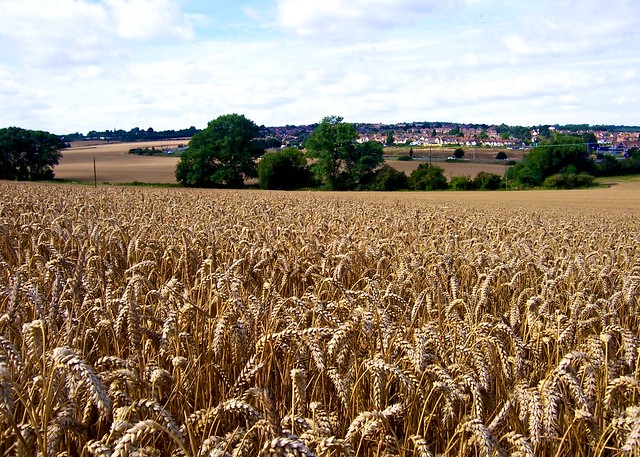 |
| Wheat field, Kent. Photo by Zohar Manor-Abel on Flickr |
GM is failing to deliver on any of these promises.
Crop yields continue to improve entirely due to conventional breeding and yield increases in comparable crops have been greater in Europe without GM crops than in the US with its vast GM monocultures.
Lower pesticide use has also been achieved in Europe without GM. Where biotech crops have been grown year on year, pesticide use has begun to escalate after a few seasons.
Nitrogen-fixing plants have never emerged from the lab, and there's no sign of them coming any time soon. Many genes are involved in the process of nitrogen-fixation and, given the extent of the side-effects now emerging from current GM crops with single artificial genes[e.g.1,2,3,4], there's no reasonable expectation of such complex plants ever being safe to grow or eat.
Beating environmental stresses with novel genes is fundamentally flawed on several counts.
Attempts so far have a dismal record:
“By the year 2005, over 1,000 applications were approved to field trial stress-tolerant GM plants in the United States alone. None ever progressed out of the testing phase.” (Heinemann).One scientific writer stated the obvious that targetting a single stress only works when the stress is actually there. The most problematic stresses, of course, vary from year to year. He said
“One problem with plants that have been genetically engineered for drought resistance is that they do poorly in wet years. Thus farmers have to try to predict the weather when they selects seeds at the start of the growing season” (Conniff).Seed suppliers have to try to predict the weather years in advance.
The gene transfer itself stresses GM plants over and above what the environment throws at them [5].
As Prof. Jack Heinemann points out
“stress tolerance is not a solution to the causes of stress. No matter how tolerant you make the plant to drought, using it in soil low in organic mater and unable to hold water will eventually further deplete the soil of moisture and the plant will struggle or die. GM is an attempt to use genetics to overcome the environment”.Over the years the pro-GM propaganda has had to be toned down from all agriculture will be GM to a more modest GM is only one tool in the box. But, is GM a useful tool or is it a dangerous distraction from the real solutions?
Soil Association Policy Director, Peter Melchett, is adamant that
“GM crops are the cuckoo in the nest - bloated, sucking resources from and ultimately destroying other farming systems. GM crops have locked farmers further into depending on costly inputs from a handful of powerful chemical companies, and have been sold on false promises. GM is a 20th century technology wholly unfit for the challenges of the 21st century”.
OUR COMMENT
The recent stern UN warning to “Wake-up Before It Is Too Late” condemns the technical tweaks with which agri-businesses, scientists and governments have become obsessed. GM is one of the most major such tweaks: it is an expensive distraction which won't solve our impending food crisis because it totally fails to deal with the underlying problem.Check out UN SAYS WAKE-UP BEFORE IT'S TOO LATE - News, October 2013.
Background reading:
[1] DANISH PIG FARMER WHISTLE-BLOWER - May 2012
[2] GM MAIZE IS NOT SAFE TO EAT - October 2012
[3] ROUNDUP PROMOTES BOTULISM - June 2013
[4] IF YOU EAT GM PLANTS, YOU WILL LIKELY HAVE GM TOXINS INSIDE YOU - June 2013
[5] STRESSED PLANTS, STRESSED PEOPLE - GMFS Archive, June 2010
SOURCES:
- Jack A. Heinemann, Keep the pause button on GM pressed,
The Hindu 7.09.13
- Peter Melchett, The GM cuckoo in the nest, Living
Earth, Autumn 2013
- Richard Conniff, Enlisting bacteria and fungi from the
soil to support crop plants is a promising alternative to the heavy
use of fertilizer and pesticides, Scientific American, September
2013
- Mae-Wan Ho, Nitrogen-fixing for All Crops Not the Answer,
Institute of Science in Society Report 23.09.13
No comments:
Post a Comment
Thanks for your comment. All comments are moderated before they are published.